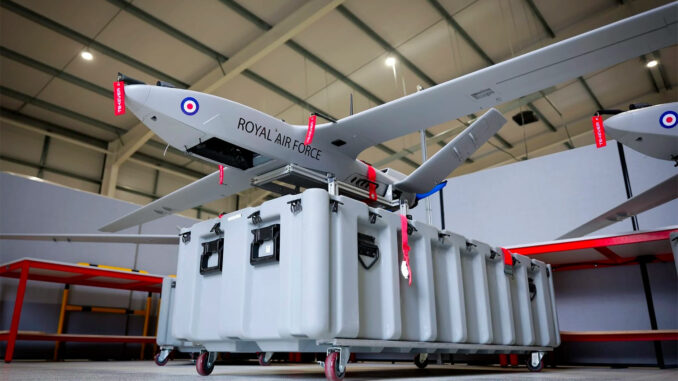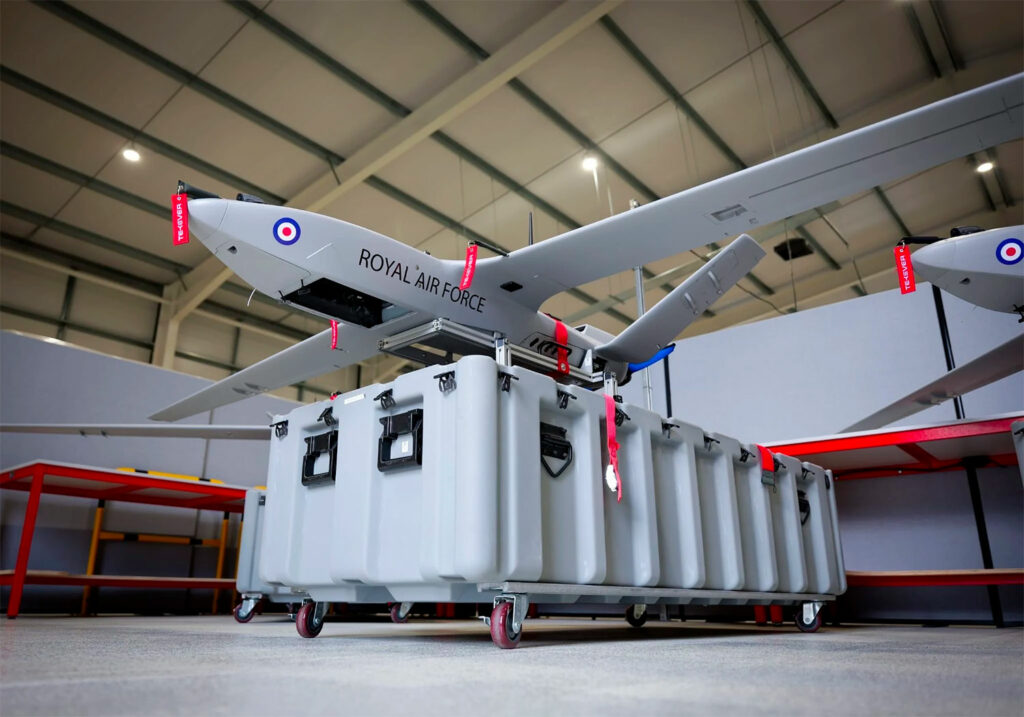
The RAF’s StormShroud drones, equipped with the BriteStorm system, improve the protection of British fighter jets by disrupting enemy radars.
On May 2, 2025, the Royal Air Force (RAF) entered service with StormShroud drones, designed to accompany Typhoon and F-35B Lightning II fighter jets. These autonomous drones are intended to disrupt enemy air defense systems, thereby reducing risks to pilots and increasing mission effectiveness.
Technical characteristics of the StormShroud drone
The StormShroud drone is a tactical platform developed on the basis of the Tekever AR3, a fixed-wing aircraft designed for ISR (Intelligence, Surveillance, Reconnaissance) missions and now adapted for electronic warfare functions. Its design is based on a compromise between endurance, compactness, and ease of deployment to meet the requirements of modern operations without heavy infrastructure.
A reliable base: the Tekever AR3 drone
The Tekever AR3 weighs 25 kg and has a wingspan of 3.5 meters. It is designed to be transported and deployed quickly by a small team, without an airstrip. Takeoff is via a pneumatic catapult, and landing is by parachute, allowing operations in unprepared terrain. This drone can reach an operational altitude of 3,600 meters, with a cruising speed of 90 km/h, and offers a 16-hour endurance, depending on the payload and weather conditions. Its range is generally estimated at between 100 and 150 kilometers in direct line via ground station, depending on the power of the control antennas and the topography.
This platform has already been used in maritime surveillance, border control, and observation missions in conflict zones, making it a proven base for more offensive applications such as electronic warfare.
The BriteStorm system: radar jamming and decoys
At the heart of the StormShroud is the BriteStorm system, a 2.5 kg payload designed by Leonardo UK. This device incorporates DRFM (Digital Radio Frequency Memory) technology, which is capable of capturing an enemy radar signal, modulating it in real time, and then sending it back in a modified form. This creates false radar echoes, simulating multiple targets or masking the true positions of allied aircraft, for example.
The BriteStorm can be reprogrammed during missions, allowing the drone to change its jamming profile depending on the enemy radars encountered. This system significantly improves the protection of piloted aircraft, particularly during SEAD (Suppression of Enemy Air Defenses) missions.
Integration into RAF operations
The deployment of StormShroud drones is part of a tactical reorganization of the Royal Air Force, particularly within the 216th Experimental Squadron, which is dedicated to integrating autonomous systems into combat mission planning and execution. This drone does not operate alone. It is designed to fly in coordination with Typhoon and F-35B fighter jets. Its main mission is to precede piloted aircraft in order to identify or disrupt enemy radars before they can engage allied aircraft.
In doing so, the StormShroud acts as an electronic shield, opening entry corridors into monitored airspace. This significantly reduces the likelihood of interception or engagement by enemy ground-to-air systems. This type of operation is comparable to a SEAD (Suppression of Enemy Air Defenses) mission, but without direct exposure of human pilots.
The StormShroud is part of the Autonomous Collaborative Platforms (ACP) doctrine. This is an operational concept adopted by the RAF to develop the use of autonomous systems capable of cooperating with manned assets. These platforms must operate in a responsive and adaptive manner, pursuing a common goal: to improve the resilience and flexibility of air forces in contested environments.
Ultimately, this integration aims to reduce dependence on humans in the early stages of offensive operations, while increasing the electronic and tactical maneuverability of British forces.

A strategic investment for the United Kingdom
The StormShroud program represents an industrial and technological lever for the United Kingdom. The UK Ministry of Defense has committed £19 million (approximately €22 million) to develop and produce these tactical electronic warfare drones. This public funding has supported around 200 highly skilled jobs across several industrial sites, including West Wales and Somerset.
This initial investment is part of a broader strategy. The Tekever group, which is responsible for developing StormShroud, has announced a private investment plan of £400 million (approximately €470 million) over five years in the United Kingdom. This funding will be used to strengthen local production capacity, develop testing and validation infrastructure, and recruit up to 1,000 engineers, technicians, and specialists. It is therefore a program with high added value in terms of skills and industrial jobs.
This initiative supports a clear political objective: to increase UK defense spending to 2.5% of GDP by 2027. This increase aims to respond to the deteriorating geopolitical environment, particularly in Eastern Europe and the South China Sea, while consolidating the national defense industrial base. The StormShroud is both an operational tool for the RAF and an economic driver for the UK’s technological fabric.
This policy also aims to reduce dependence on foreign suppliers for critical technologies by encouraging defense companies to set up and develop their skills in the UK.
Lessons learned from recent conflicts
The development of the StormShroud is largely based on operational lessons learned from the use of drones during conflicts in Ukraine and the Middle East. Since 2022, the Tekever AR3 and AR5 models have been used in various theaters of operation, including for intelligence, surveillance, and tactical support. According to data provided by the manufacturer, these platforms have accumulated more than 10,000 flight hours in environments with high electronic threat density.
In Ukraine, the drones were used to locate artillery positions, track troop movements, and map enemy radar networks. Their low thermal and acoustic signature makes them difficult to detect, enabling extended missions over contested areas. Their widespread use in real-world conditions has highlighted the resilience of autonomous platforms to jamming, as well as their ability to adapt quickly to changing terrain.
These experiences have reinforced a reality that is now accepted in military doctrine: drones are no longer limited to surveillance functions. They have become active vectors of electronic warfare, tactical disruption, and remote neutralization. Feedback also shows that the loss of a drone, even when equipped, is much less critical than that of a manned aircraft, both in terms of cost and political impact.
The StormShroud was therefore designed to meet these new requirements: to operate without a pilot in high-risk areas, neutralize defensive systems before fighter jets are deployed, and remain flexible in use in degraded environments. This model incorporates scalable capabilities that will allow additional payloads to be added or tactical programming to be modified as needed without redesigning the entire system.
Outlook and implications
The introduction of StormShroud drones marks an evolution in British military strategy, emphasizing the integration of autonomous technologies to enhance national security. By disrupting enemy defense systems, these drones increase the survivability of manned aircraft and offer new operational capabilities to the RAF.
This technological advance could also influence the military doctrines of other nations, prompting wider adoption of autonomous systems in the armed forces.
War Wings Daily is an independant magazine.